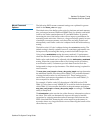
StorNext File System Tuning
Distributed LAN Client Vs. Legacy Network Attached Storage
StorNext File System Tuning Guide 22
Performance 0 DLC outperforms NFS and CIFS for single-stream I/O and provides
higher aggregate bandwidth. For inferior NFS client implementations,
the difference can be more than a factor of two. DLC also makes
extremely efficient use of multiple NICs (even for single streams,)
whereas legacy NAS protocols allow only a single NIC to be used. In
addition, DLC clients communicate directly with StorNext metadata
controllers instead of going through an intermediate server, thereby
lowering IOP latency.
Fault tolerance 0 DLC handles faults transparently, where possible. If an I/O is in progress
and a NIC fails, the I/O is retried on another NIC (if one is available). If a
Distributed LAN Server fails while an I/O is in flight, the I/O is retried
on another server (if one is running). When faults occur, applications
performing I/O will experience a delay but not an error, and no
administrative intervention is required to continue operation. These fault
tolerance features are automatic and require no configuration.
Load Balancing 0 DLC automatically makes use of all available Distributed LAN Servers in
an active/active fashion, and evenly spreads I/O across them. If a server
goes down or one is added, the load balancing system automatically
adjusts to support the new configuration.
Client Scalability 0 As the following table shows, DLC supports a significantly larger number
of clients than legacy NAS protocols:
Robustness and
Stability
0 The code path for DLC is simpler, involves fewer file system stacks, and
is not integrated with kernel components that constantly change with
every operating system release (for example, the Linux NFS code).
Largest Tested Configuration
Number of Clients Tested (via
simulation)
NFS CIFS DLC
441000


















